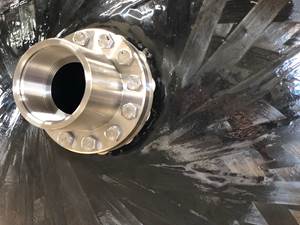Fully transparent, rollable electronics built with graphene/CNT backbone
Carbon nanotubes and graphene provide mechanical properties and bonding enabling high-temp polyimide resin to provide flexible circuit substrate.
As reported by Nanowerk.com, the coming age of wearable electronic devices is driving pursuit of flexible, transparent electronics. While both have been previously demonstrated, fully transparent circuits on a rollable substrate have not. However, a research team in Korea has now successfully produced rollable and transparent electronics that are not only lightweight but also damage-resistant.
Flexible electronics require a bendable substrate on which to build-up the device. Plastics are flexible, resist damage and also provide required insulation for circuits. However, they are typically restricted to temperatures below 100°C to avoid warpage while temperatures during circuit processing are much higher. There is also a difficulty in handling flexible electronics during the manufacturing process. A team led by professor Jin Jang at Kyung Hee University (Seoul, South Korea) has overcome these issues, as reported in the article, “Fully Transparent and Rollable Electronics” in the journal ACS Applied Materials & Interfaces.
Jang chose polyimide (PI) polymer — which can withstand processing temperatures around 300°C — as the plastic substrate. It also has high chemical resistance and can be colorless. An amorphous oxide semiconductor made from indium-gallium-zinc-oxide (a-IGZO) assures good device performance as do metal electrodes made from indium-zinc-oxide (IZO). Both are also transparent to visible light. Jang reports that the final product is see-through with a transmittance of 70% using colorless PI that is 15 µm thick. With the electronic devices only ∼1 µm thick, the total thickness of the thin-film transistor (TFT) is only ∼16 µm, and the resulting electronic devices are rollable.
To address the difficulty in handling during fabrication, the researchers used a carrier glass substrate — plate glass roughly 0.7mm thick — onto which the colorless PI is first spin-coated from solution, and then detached from once circuit device fabrication is completed. The carrier glass is rigid enough to provide the mechanical support for the polymer, without which accurate layer registration during circuit fabrication is impossible.
However, the polymer substrate must be attached to the glass carrier. Because most adhesives can also not withstand processing temperatures, one solution is to spin-coat the flexible substrate from solution onto the carrier glass. The challenge now is how to detach the two because their bond strengthens during circuit processing. Jang’s team did not want to use a thin layer of amorphous silicon between the two because it requires expensive lasers and a complex separation process. They instead spin coat a mixture of carbon nanotubes (CNT) and graphene oxide (GO) from solution onto of the carrier glass before spin coating the colorless PI. Jang explains that the CNT/GO layer has a flake like structure that decreases where the PI contacts the glass, reducing its adhesion. "Inserting the CNT/GO layer also doesn't cost much because only a few drops are required to achieve a thickness around 1 nm," Jang adds.
After fabrication, a small amount of mechanical force is able to detach the PI from the glass. Another advantage is that the CNT/GO layer bonds better to the CPI vs. to the carrier glass, so that the CNT/GO remains embedded to the backside of the PI and provides mechanical support while making the rollable electronics wrinkle-free. Further, electronic devices built on plastic substrates are prone to electrostatic discharge (ESD) damage because plastics are usually associated with the generation of electrostatic charge. By contrast, the colorless PI developed here can release localized ESD via the conductive CNT.
Jang’s team rolled the TFT devices 100 times on a cylinder with a 4mm radius, without significantly degrading their electrical performance. Integrated circuits also operated without degradation, while being bent to a radius of 2 mm, making these devices well-suited for transparent and rollable displays.
Related Content
Combining multifunctional thermoplastic composites, additive manufacturing for next-gen airframe structures
The DOMMINIO project combines AFP with 3D printed gyroid cores, embedded SHM sensors and smart materials for induction-driven disassembly of parts at end of life.
Read MorePlant tour: Teijin Carbon America Inc., Greenwood, S.C., U.S.
In 2018, Teijin broke ground on a facility that is reportedly the largest capacity carbon fiber line currently in existence. The line has been fully functional for nearly two years and has plenty of room for expansion.
Read MoreInfinite Composites: Type V tanks for space, hydrogen, automotive and more
After a decade of proving its linerless, weight-saving composite tanks with NASA and more than 30 aerospace companies, this CryoSphere pioneer is scaling for growth in commercial space and sustainable transportation on Earth.
Read MoreJEC World 2024 highlights: Thermoplastic composites, CMC and novel processes
CW senior technical editor Ginger Gardiner discusses some of the developments and demonstrators shown at the industry’s largest composites exhibition and conference.
Read MoreRead Next
Next-gen fan blades: Hybrid twin RTM, printed sensors, laser shock disassembly
MORPHO project demonstrates blade with 20% faster RTM cure cycle, uses AI-based monitoring for improved maintenance/life cycle management and proves laser shock disassembly for recycling.
Read MoreUltrasonic welding for in-space manufacturing of CFRTP
Agile Ultrasonics and NASA trial robotic-compatible carbon fiber-reinforced thermoplastic ultrasonic welding technology for space structures.
Read MoreScaling up, optimizing the flax fiber composite camper
Greenlander’s Sherpa RV cab, which is largely constructed from flax fiber/bio-epoxy sandwich panels, nears commercial production readiness and next-generation scale-up.
Read More











